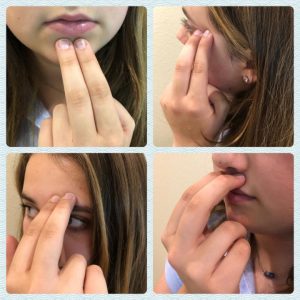 Nearly 25 years ago I was participating in a national conference for trauma counselors. I attended a workshop about, what was then, a fairly new therapeutic approach called Thought Field Therapy. The class was taught by a reputable and experienced therapist and college professor, Dr. Robert Bray. As he began to explain this very different approach to alleviating traumatic upset however, my inner skeptic began to put on the brakes. Thought Field Therapy, or TFT, he explained, is a therapeutic treatment discovered and perfected by Dr. Roger Callahan. It involves tapping on a series of points on the body, located along meridians of energy. When the correct sequence is discovered, stimulating these “pressure points” by tapping gently will alleviate emotional upset, anxiety, phobias, even addictive urges. Further, if the treatment is applied correctly, in most cases the disturbing symptoms will not return! I smiled inwardly and wondered how he was able to slide this “hippie voo-doo” past the board and be allowed to present at a respected trauma conference. Then he offered to demonstrate the technique.
Nearly 25 years ago I was participating in a national conference for trauma counselors. I attended a workshop about, what was then, a fairly new therapeutic approach called Thought Field Therapy. The class was taught by a reputable and experienced therapist and college professor, Dr. Robert Bray. As he began to explain this very different approach to alleviating traumatic upset however, my inner skeptic began to put on the brakes. Thought Field Therapy, or TFT, he explained, is a therapeutic treatment discovered and perfected by Dr. Roger Callahan. It involves tapping on a series of points on the body, located along meridians of energy. When the correct sequence is discovered, stimulating these “pressure points” by tapping gently will alleviate emotional upset, anxiety, phobias, even addictive urges. Further, if the treatment is applied correctly, in most cases the disturbing symptoms will not return! I smiled inwardly and wondered how he was able to slide this “hippie voo-doo” past the board and be allowed to present at a respected trauma conference. Then he offered to demonstrate the technique.
Dr. Bray asked if anyone had an upsetting or traumatic experience that they would like him to treat. A woman in our group volunteered. Her chest heaved as she fought tears. She was finally able to get out that she had lost her 6-year-old daughter to leukemia within the last few weeks. She explained that she helplessly held her in her arms as she passed away. Dr. Bray quietly led her through a series of tapping points. We all watched as the redness left her face, and her breathing slowed and normalized. We watched her shoulders relax and her expression soften. Within minutes she was able to calmly tell us more of her story. Most of us wept as we listened. It was undeniably sad and tragic. But where had her overwhelming traumatic reaction gone? He asked her when was the last time she was able to talk about her precious daughter, or tell her story to someone. She said she had not been able to until just now. He asked her if she would be willing to have those of us in attendance approach her over the next couple of days and ask her how she was doing after this treatment. She agreed.
The next day I saw this woman among the crowd. I debated whether to bother her, but I was so interested to know if, 24-hours later, she had decided that this was simply a distraction or a fluke, or whether she believed it had helped her. I quietly approached her. I expressed my sorrow for the loss of her sweet daughter and asked how she was doing today. She said she was sure that the loss of her little girl would always be the greatest sadness in her life, but…she could breathe again. She said she slept last night for the first time in months.
As a law-enforcement based crisis response counselor, I struggled every day to help people find the energy to keep moving through their pain, to teach them coping mechanisms that would help them rebuild a life worth living. My inner skeptic was still sounding warning bells, but if there was a possibility that this technique would help alleviate some of the most profound pain that my clients struggled with, I wanted to know more. I had some money in my budget and although I was still skeptical, I decided to take the gamble. I registered myself, and my victim services coordinator, to be trained and certified in Thought Field Therapy.
During the training Dr Bray insisted that we identify and treat our own real-life issues. He wanted us to not just learn a technique but experience the effects of this treatment. That first day we cured my near-phobic, fear-reaction to spiders. Today, while I would not choose a tarantula for a pet, I will carry a spider outside to live in my garden rather than screaming and begging someone to pound it to death with a shoe. Twenty-five years later, that overwhelming panic response to spiders has not returned. More importantly, I found relief for the residual pain of several past traumatic experiences. I was intrigued.
The real test, however, was whether this technique would help relieve the pain of the people I served who struggled with the traumatic impact of murder, suicide, sexual assault, domestic battering, and fatal accidents. And guess what? It did. No intervention will ever change the reality of the struggles and losses that life eventually brings to all of us. But when the overwhelming traumatic response is lifted, we are able to process these experiences with new insight. We are able to turn hurt into hope, and struggle into character and wisdom.
I am someone who likes scientific proof, empirical studies, and neuro-biological explanations, and since my first exposure to TFT, more of this has become available. Thought Field Therapy has been endorsed by professors of psychiatry, psychologists, and anxiety and traumatic stress researchers. Today, there are even techniques that have been modeled after Dr. Callahan’s original Thought Field Therapy, such as EFT (Emotional Freedom Techniques). However, none of this has left near the impression on me as the grief-stricken mother with unbearable pain, who after just a few minutes of tapping, could “breathe again”.
By Helen Thueson-Stone, M.A., TFT-Dx

Helen Thueson-Stone has over 25 years of experience in crisis intervention, trauma recovery, teaching, professional training and speaking. She is the owner and Director of Stone Mountain Wellness Center & Training Institute in Boise, Idaho.
*For more information about using tapping to treat trauma, anxiety, and addictions, e-mail the author at [email protected]
Also, watch the calendar of events for upcoming training opportunities in Thought Field Therapy.


Tonya
Twenty years ago, my life came to a standstill. I faced crushing debt, existed on half the accustomed income, and had two small children to care for on my own. I couldn’t cry on the way to work because I didn’t want my students or coworkers to know. I couldn’t cry at home because I didn’t want to upset my children. Pretty soon I couldn’t cry at all. I was filled with darkness and dread. Helen took me through the TFT technique and I was able to relax and feel and process difficult emotions again.